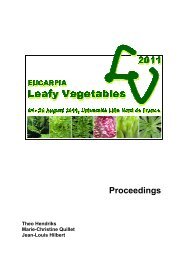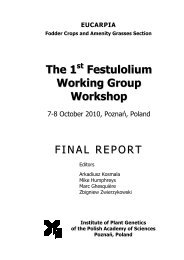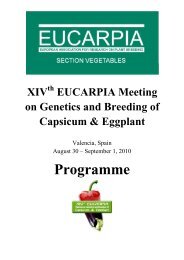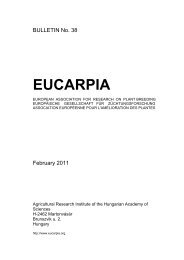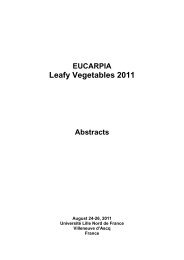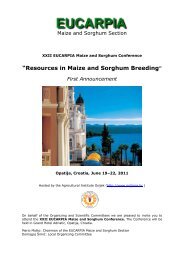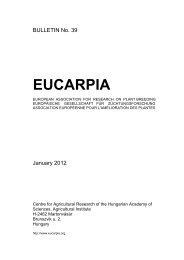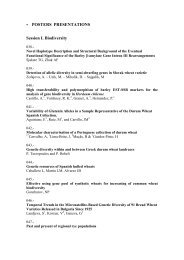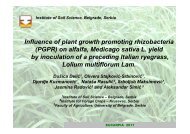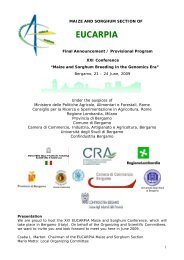Plant breeding for organic and sustainable, low-input agriculture
Plant breeding for organic and sustainable, low-input agriculture
Plant breeding for organic and sustainable, low-input agriculture
Create successful ePaper yourself
Turn your PDF publications into a flip-book with our unique Google optimized e-Paper software.
Methodology of testing of the suitability of varieties <strong>for</strong> the condition of <strong>organic</strong> farming<br />
Petr Konvalina, Zdeněk Štěrba, Jan Moudrý<br />
University of South Bohemia, České Budějovice, Czech Republic<br />
The Czech <strong>organic</strong> production of cereals is characterised by <strong>low</strong> <strong>and</strong> fluctuating yield which is<br />
caused by an absence of varieties bred <strong>and</strong> tested specifically <strong>for</strong> the conditions of <strong>organic</strong><br />
farming. The farmers nevertheless need the varieties adapted to this type of management<br />
(Lammerts van Bueren, 2002). However, the testing of the varieties <strong>for</strong> certain station conditions<br />
would be very expensive (Wolfe, 2002). Because the proportion of arable l<strong>and</strong> is <strong>low</strong> <strong>and</strong> the<br />
area of <strong>organic</strong> cereals is small there, the official tests are not supposed to be established in the<br />
Czech Republic. There<strong>for</strong>e, it is a need to create a simple methodology of testing <strong>for</strong> suitability<br />
of varieties at an <strong>organic</strong> farm <strong>and</strong> at breeder's level.<br />
In 2006, a work version of the „Methodology“ has been conceived. The part of methodology <strong>for</strong><br />
evaluating biological characteristics such as resistance to diseases is based on the methodology<br />
of Central Institute <strong>for</strong> Supervising <strong>and</strong> Testing in Agriculture <strong>for</strong> tests of VCU. The Descriptor<br />
of genus Triticum L. <strong>for</strong> the international evaluation of genetic ressources is applied <strong>for</strong><br />
evaluating the morphological <strong>and</strong> economic characters. Some characters are also evaluated<br />
according to the h<strong>and</strong>book called Cereal variety testing <strong>for</strong> <strong>organic</strong> <strong>and</strong> <strong>low</strong> <strong>input</strong> <strong>agriculture</strong><br />
(especially competitivness, etc.). Methodology is being tested in small-plot trials at two stations<br />
under two different types of the l<strong>and</strong>-climatic conditions (production, non-production areas). The<br />
testing has been carried out with a divers set of varieties (modern, obsolete cultivars, l<strong>and</strong>races of<br />
spring wheat <strong>and</strong> emmer wheat).<br />
The methodology is divided into four parts: morphological, biological, economic <strong>and</strong> quality<br />
characters. When evaluating each character, a user finds a code, name, description, scale of the<br />
evaluation <strong>and</strong> point evaluation of each character, combined with its importance <strong>for</strong> <strong>organic</strong><br />
farming system. The characters may be evaluated as individual results in each category of the<br />
morphological, biological, economic <strong>and</strong> quality characters or as a sum of all of them <strong>and</strong> a<br />
variety number may be indicated. The Methodology may be used by several users. A farmer can<br />
find a list of characteristics which can be evaluated in the agroecosystem, in particular l<strong>and</strong>climatic<br />
conditions of a particular farm there. He is able to test the suitability of the varieties<br />
available. A breeder can find a proposal of the characteristics serving as a simple indicator of the<br />
suitability <strong>for</strong> the screening of the considerable collections of the genetic resources. The main<br />
difference between the testing of the varieties in <strong>organic</strong> system <strong>and</strong> conventional one is based<br />
on an emphasis on indirect measurable indicators as the morphological characteristics are, e. q.: a<br />
distance between flag leaf <strong>and</strong> spike which is very important <strong>for</strong> the spreading of Septoria<br />
nodorum infection or the optimal position, length <strong>and</strong> width of flag leaf as a condition <strong>for</strong> a<br />
higher degree of the assimilation of sunlight.<br />
Acknowledgement: The project is funded by the MSM 6007665806<br />
32




